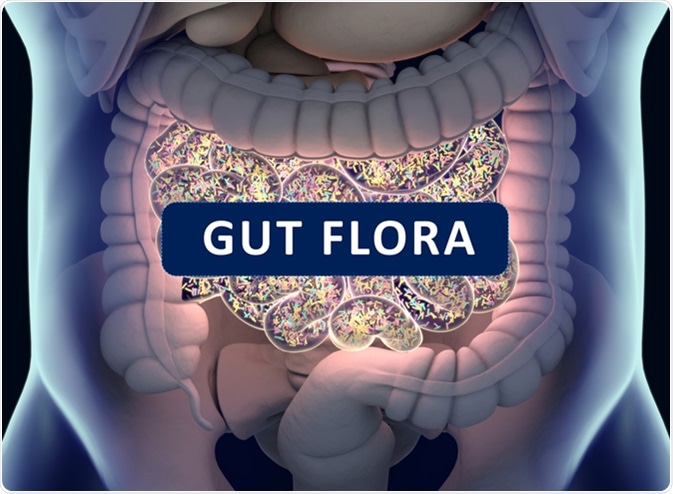The intestine is colonized by enteric bacteria immediately after birth, and this prevents the growth of pathogenic bacteria in the small intestine. The composition of the intestinal bacterial population remains constant during the individual’s lifespan unless altered by extrinsic means.

Gut bacteria, gut flora, microbiome. Bacteria inside the small intestine 3D illustration. Image Credit: Anatomy Insider / Shutterstock
Normal Enteric Microflora
In normal circumstances, the acidity of the stomach and the first part of the small intestine prevent the growth of bacteria to any significant extent, so that in a third of people, no bacteria are obtained on culturing jejunal aspirates. If present, they consist of lactobacilli, enterococci and a few other species. This changes in the terminal ileum, where the bacterial counts increase sharply from 103 colony-forming units (CFU) in the jejunum to as high as 109 CFU in this region.
The bacterial concentration in the colon is still higher, at 1012 CFU, and the main constituents are anaerobes such as bifidobacteria, lactobacilli, and clostridia. The colonic bacteria play an important role in host immune function, producing useful short-chain fatty acids from unabsorbed sugars ingested through the diet, and thus serving the energy demands of the colonic mucosal cells. Thus, their presence is essential to normal colonic health and integrity.
Why The Microbiome Is The Future Of Medicine | Dr. Robynne Chutkan | Revitalize
SIBO and its Importance
Small intestinal bacterial overgrowth (SIBO) occurs when colonic flora grow upward to colonize the small bowel as well.
This interferes with the functions of the small intestine, namely, digestion and absorption of ingested food. The small intestinal epithelium is permeable compared to the colon, to enable free passage of digestive metabolites across the intestinal wall.
The presence of colonic bacteria means that they take up some of the nutrients, competing with the host, and may also enter the bloodstream across the epithelial walls.
SIBO plays a role in many conditions, according to current medical theories. These range from bowel disorders such as celiac disease, inflammatory bowel disease, and irritable bowel syndrome, to fibromyalgia.
The exact biochemical pathways are difficult to describe, so that evidence is still lacking as to the etiologic role of SIBO. It is also possible that it is a consequence or an accompanying but unrelated phenomenon in these disorders.
However, abnormalities of intestinal motility as well as chronic pancreatitis are known to be most commonly associated with SIBO.
Management
The definition of SIBO is still evolving, though the traditional term denotes a number of 105 or more CFU in the proximal small intestine. This is because the number of CFU will necessarily depend upon the location of the aspirated sample and the ease of culture of up to 60% of the intestinal bacteria.
For this reason, breath tests have become popular for the diagnosis of SIBO. This is because of the SIBO-associated malabsorption which produces fermentation and gases such as hydrogen. The prevalence varies from 12 to 35% depending upon the breath test used.
Diagnosis of SIBO is, as described above, by culture of jejunal aspirates and breath testing. Management includes treating any underlying disease which predisposes one to the overgrowth of bacteria, giving appropriate antibiotic therapy to eradicate the overgrowth, and correcting nutritional abnormalities.
Follow Your Gut: Microbiomes and Aging with Rob Knight - Research on Aging
References
- https://www.ncbi.nlm.nih.gov/pmc/articles/PMC3099351/
- https://medlineplus.gov/ency/article/000222.htm
- http://www.gastrojournal.org/article/S0016-5085(79)91337-4/pdf
Further Reading